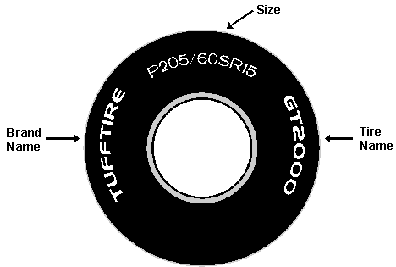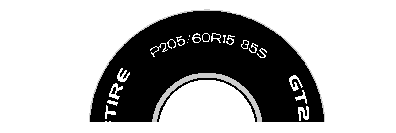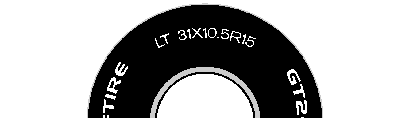

Reading Your TiresWhen it's time to replace your tires, you have to know what brand and type you want, as well as their size. This information is printed on the sidewall. Brand name and tire name are easy enough to find -- sometimes they're even printed in raised white letters.
 Tire size is measured in a combination of millimeters, letter codes and inches. The size of the tire pictured above is: P205/60SR15. The first letter is "P" for passenger tire. The first number is the tire's width in millimeters -- in this case 205mm. The second number is its aspect ratio -- the ratio of sidewall height to width (also known as "profile"). In this case the sidewall height is 60 per cent of 205mm -- or 123mm. This tire is speed-rated, so the second letter is the speed rating -- in this case it's "S" (112 mph). Speed ratings give a general idea of a tire's overall performance characteristics -- a family sedan needs no more than an "S" rated tire, while a Ferrari will use a "Z" rated tire. Tires with high speed ratings are more expensive and shorter-lived than tires with low speed ratings. Speed ratings use the following letter codes:
The next letter is "R" for radial construction -- a superior design to the bias ply tires of old. The last number designates the wheel diameter -- this tire mounts on a 15-inch wheel.  Sometimes a load index and a speed rating are printed together following the size designation. This tire's size is: P205/60R15 85S. "85S" means that this tire's load index is 1135 lbs. and it has a speed rating of "S." This means that four tires can safely carry a maximum weight of 4540 lbs. (4 tires x 1135 lbs.) at 112 mph. This is something most drivers never have to worry about, but here's a sampling of some load ratings:
Some light truck tires use a different sizing system.  This tire's size is LT 31X10.5R15. The first two letters stand for "light truck." The first number is the tire's diameter in inches -- in this case, 31-inches. The second number is its width in inches, 10.5-inches. The "R" stands for radial. The 15 designates wheel diameter -- this tire is made to fit on a 15-inch wheel. -------------------------------------------------------------------------------- The very small type on the tire's sidewall contains the following information: Uniform Tire Quality Grades are also printed on the sidewall. These grades are a result of government mandated tests that measure treadwear, traction and temperature resistance. The actual testing and grading is done by the manufacturer, so take these ratings with a grain of salt. Treadwear measures how long the tread should last compared with a reference standard of 100. A treadwear rating of 400 means that the tread wears four times as well as the standard. This grade is only accurate for comparing tires within a certain brand.M + S: Means the tire has the minimum required mud and snow traction. Maximum Load: Maximum weight that the individual tire can support -- shown in pounds or kilograms. Maximum Inflation Pressure: Shown in psi (pounds per square inch) or kPA (kilopascals). Never inflate your tires over the maximum inflation pressure. D.O.T. Serial Number: Shows compliance with Department of Transportation regulations along with the coded name of the tire manufacturer and the place and date of manufacture. The date of manufacture is shown by the last three digits of the serial number -- if it ends in 405, that means the tire was made in the fortieth week of 1995. Because rubber can dry out and deteriorate, tires that are extremely old can be more prone to failure than newer tires. Tire Construction: Shows the number and type of plies (interwoven belts) which make up the tire's tread and sidewall. |
|
Greensboro, N.C. 27403 (336) 852-8909 |
|
|
|
|
|
|
|